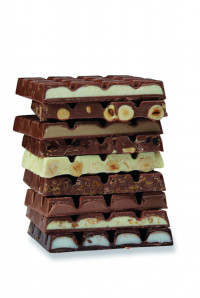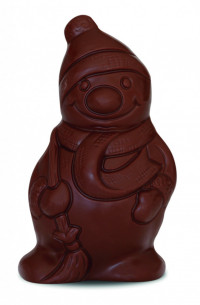The industrial manufacture of chocolate products is technically demanding. Holger Brack, Head of Product Technology Lab at Winkler und Dünnebier Süßwarenmaschinen GmbH (WDS), provides a sound summary of basic knowledge about chocolate masses and depositing.
In general, chocolate is a suspension of finely rolled or milled solid particles consisting of sugar, milk solids and fat-free cocoa ingredients in a continuous chemical fat phase of cocoa butter. Depending on the cocoa and milk components, a distinction can be made between bitter and milk chocolate. White chocolate, by the way, is a milk chocolate that contains no fat-free cocoa solids anymore.
In warm state (40 to 45 °C), this suspension is – due to the molten fat – a liquid pasty aggregate which by cooling cures within a few minutes to a solid partly shiny mass. In order to generate this solid and shining structure, on the one hand, the addition of the emulsifier lecithin is required to firmly embed the solid particles in the fat melt. On the other hand, a special tempering and cooling process is required. Solid chocolate bars are the classic among chocolate products – common, simple and popular. Today, they are manufactured in fully automatic, mostly one-lane moulding plants. Depending on the type of chocolate and the ingredients, the chocolate masses are deposited by an accompanying piston depositor with rotating cutting knife. All machinery movements are servo-controlled, with all functions being monitored and controlled by a control panel.
Shell moulding plants have been specially designed for filled chocolate products such as pralines and bars. Many individual steps characterize the classical route for the production of a filled chocolate product. First, a chocolate shell is manufactured. It is created by filling the mould with chocolate, a subsequent vibration, then turning and spinning the mould, cleaning (by a licking roller), turning back and finally cooling. After production, the shell is filled. For this purpose, in the simplest case, a filling mass is deposited via depositor. It is also possible to insert in several steps different masses and/or ingredients such as whole nuts, wafers or biscuits.
After filling the shell and re-cooling the filling mass, the shell still needs to be closed. During this process, chocolate is deposited again onto each product by means of a bottom deposi-tor. To seal the rim, the cooled products in the mould are pre-heated so that the top edge of the shell melts a little. After re-vibrating, surplus chocolate is removed from the moulds by a double-cross scraper, forming a smooth bottom. Finally, the hollow figures are cooled and discharged.
The cold stamping process is an intelligent alternative for the production of hollow parts. During this process, pre-tempered chocolate is deposited into a mould and then demoulded to a defined shell thickness by means of a cooled metal stamp which exactly matches the mould.
The defined shell thickness and geometry are a big advantage of the cold stamping technology. While with the classical method shape and thickness of the shell always depend on the type of chocolate and its flow behaviour, with the cold stamping process the shell is always the same. Another advantage is the possibility of the shell rim design to allow a strong and tight connection between the shell and lid.
Mature and in use worldwide is One-shot technology. The advantage of this method clearly lies in the low investment volume. The One-shot depositor has two separate and separately heated hoppers from where the tempered chocolate and the filling are deposited into the moulds via a servo-electric piston slider system. This is done independently of each other by concentric nozzles (inner channel for the filling compound and external ring channel for the chocolate). Provided that the viscosities of both compounds are well matched and both masses show good flow and tear off behaviour, almost perfect chocolate products can be produced.
An advanced development of the One-shot technology is the Triple-shot process, designed and patented by Winkler und Dünnebier Süßwarenmaschinen GmbH (WDS) in Rengsdorf/Germany. In this process, three masses are deposited into one product independently of one another via a double-concentric nozzle. With Triple-shot and only one depositor, chocolates or bars with double filling or double shell can be produced in one process. A double shell is useful for efficiently retarding fat bloom or alcohol migration. Fillings can be arranged according to the programmed depositing parameters inside each other (centre in centre) or on top of each other (centre on centre). Filling ratios are freely selectable.
Hollow figures such as chocolate Santa Clauses or Easter Bunnies are most popular. Traditionally, for the conventional production of hollow figures spinning lines are used. Such machine types include, for example, the Type 172 spinning line from WDS. Using this technology, the tempered chocolate is deposited into a book mould consisting of two matching halves. After closing the book mould, a rotation process is carried out using cold and vibration over two spatial axes. Therein, the chocolate distributed uniformly on the inner walls of the mould hardens. After successful contraction and hardening, the book mould can be opened and the chocolate hollow figure can be removed.
However, hollow figures can also be produced using cold stamping technology. Thereby, half shells are precisely and accurately stamped and then cooled. The advantage of this technology – in addition to the precise shell moulding and the resulting material savings – is the fact that the products can be fed with fillings and/or other deposits like wafers, biscuits, toys or surprises before closing. Combining One-shot technology with the cold stamping process, it is also possible to produce filled hollow figures.
http://www.w-u-d.com/schokolade






